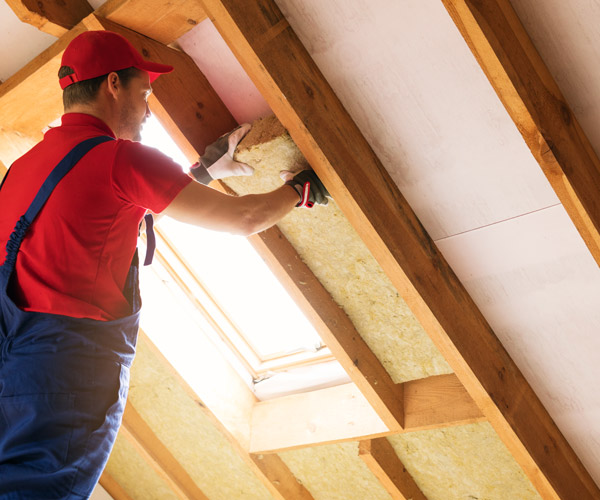Insulation
Insulation
You can reduce your home’s heating and cooling costs through proper insulation techniques. These techniques will also make your home more comfortable.
Any air sealing efforts will complement your insulation efforts, and vice versa. Proper moisture control and ventilation strategies will improve the effectiveness of air sealing and insulation and vice versa.
Therefore, a home’s energy efficiency depends on a balance between all of these elements: Air Sealing, Insulation, Moisture control, Ventilation
*A proper balance between all of these elements will also result in a more comfortable, healthier home environment.

How Insulation Works
You need insulation in your home to provide resistance to heat flow. The more heat flow resistance your insulation provides, the lower your heating and cooling costs.
Heat flows naturally from a warmer to a cooler space. In the winter, this heat flow moves directly from all heated living spaces to adjacent unheated attics, garages, basements, and even to the outdoors. Heat flow can also move indirectly through interior ceilings, walls, and floors-wherever there is a difference in temperature. During the cooling season, heat flows from the outdoors to the interior of a house.
To maintain comfort, the heat lost in the winter must be replaced by your heating system and the heat gained in the summer must be removed by your cooling system. Properly insulating your home will decrease this heat flow by providing an effective resistance to the flow of heat. An insulation’s resistance to heat flow is measured or rated in terms of its thermal resistance or R-value.
Adding Insulation to an Existing Home
Unless your home was specially constructed for energy efficiency, you can usually reduce your energy bills by adding more insulation. Many older homes have less insulation than homes built today, but adding insulation to a newer home may also pay for itself within a few years.
To determine whether you should add insulation, you first need to find out how much insulation you already have in your home and where.
A qualified home energy auditor will include an insulation check as a routine part of a whole-house energy audit. An energy audit will also help identify areas of your home that are in need of air sealing. (Before you insulate, you should make sure that your home is properly air sealed.)
If you don’t want an energy audit, you need to find out the following:
- Where your home is, isn’t, and/or should be insulated
- What type of insulation you have
- The R-value and the thickness or depth (inches) of the insulation you have
If you live in a newer house, you can probably find out this information from the builder. If you live in an older house, you’ll need to inspect the insulation yourself if you don’t want an energy audit.
Inspecting and Evaluating Your Insulation
- Check the attic, walls, and floors adjacent to an unheated space, like a garage or basement. The structural elements are usually exposed in these areas, which makes it easy to see what type of insulation you have and to measure its depth or thickness (inches).
- Inspect the exterior walls using an electrical outlet:
- Turn off the power to the outlet.
- Remove the outlet cover and shine a flashlight into the crack around the outlet box. You should be able to see if there is insulation in the wall and possibly how thick it is.
- Pull out a small amount of insulation if needed to help determine the type of insulation.
- Check outlets on the first and upper floors, if any, and in old and new parts of a house. Just because you find insulation in one wall doesn’t mean that it’s everywhere in the house.
- Inspect and measure the thickness (inches) of any insulation in unfinished basement ceilings and walls, or above crawl spaces. If the crawl space isn’t ventilated, it may have insulation in the perimeter wall. If your house is relatively new, it may have been built with insulation outside the basement or foundation walls. If so, the insulation in these spaces won’t be visible. The builder or the original homeowner might be able to tell you if exterior insulation was used.
- Once you’ve determined the type of insulation you have in these areas and its thickness (inches), see the U.S. Department of Energy’s online Insulation Fact Sheet for how to determine the R-values of insulation previously installed in your home.
The R-Value of Insulation
An R-value indicates an insulation’s resistance to heat flow. The higher the R-value, the greater the insulating effectiveness.
The R-value depends on the type of insulation and includes its material, thickness, and density. When calculating the R-value of a multi-layered installation, add the R-values of the individual layers. Installing more insulation in your home increases the R-value and the resistance to heat flow.
The effectiveness of an insulation’s resistance to heat flow also depends on how and where the insulation is installed. For example, insulation that is compressed will not provide its full rated R-value. The overall R-value of a wall or ceiling will be somewhat different from the R-value of the insulation itself because some heat flows around the insulation through the studs and joists. Therefore, it’s important to properly install your insulation to achieve the maximum R-value.
The amount of insulation or R-value you’ll need depends on your climate, type of heating and cooling system, and the section of the house you plan to insulate.
Determining Recommended R-Values
When you find out the R-values of your insulation either from an energy audit, the home builder, or your own inspection, you can then use the U.S. Department of Energy’s Zip-Code Insulation Program to determine how much insulation you should add and where to achieve the recommended insulation levels for maximum energy efficiency.
Types of Insulation
When insulating your home, you can choose from many types of insulation. To choose the best type of insulation, you should first determine the following:
• Where you want or need to install/add insulation
• The recommended R-values for areas you want to insulate
The table below provides an overview of most of the available insulation forms, insulation materials, their installation methods, where they’re applicable to install in a home, and their advantages.
Table 1. Types of Insulation
| Form | Insulation Materials | Where Applicable | Installation Method(s) | Advantages |
|---|---|---|---|---|
| FormBlanket: batts and rolls | Insulation MaterialsFiberglass, Mineral (rock or slag) wool, Plastic fibers, Natural fibers | Where ApplicableUnfinished walls, including foundation walls, and floors and ceilings. | Installation Method(s)Fitted between studs, joists, and beams. | AdvantagesDo-it-yourself. Suited for standard stud and joist spacing, which is relatively free from obstructions. |
| FormConcrete block insulation | Insulation MaterialsFoam beads or liquid foam: Polystyrene, Polyisocyanurate or Polyiso, Polyurethane, Vermiculite or Perlite pellets | Where ApplicableUnfinished walls, including foundation walls, for new construction or major renovations. | Installation Method(s)Involves masonry skills. | AdvantagesAutoclaved aerated concrete and autoclaved cellular concrete masonry units have 10 times the insulating value of conventional concrete. |
| FormFoam board or rigid foam | Insulation MaterialsPolystyrene, Polyisocyanurate or polyiso, Polyurethane | Where ApplicableUnfinished walls, including foundation walls; floors and ceilings; unvented low-slope roofs. | Installation Method(s)Interior applications: must be covered with 1/2-inch gypsum board or other building-code approved material for fire safety. Exterior applications: must be covered with weatherproof facing. | AdvantagesHigh insulating value for relatively little thickness. Can block thermal short circuits when installed continuously over frames or joists. |
| FormInsulating concrete forms (ICFs) | Insulation MaterialsFoam boards or foam blocks | Where ApplicableUnfinished walls, including foundation walls, for new construction. | Installation Method(s)Installed as part of the building structure. | AdvantagesInsulation is literally built into the home's walls, creating high thermal resistance. |
| FormLoose-fill | Insulation MaterialsCellulose, Fiberglass, Mineral (rock or slag) wool | Where ApplicableEnclosed existing wall or open new wall cavities; unfinished attic floors; hard-to-reach places. | Installation Method(s)Blown into place using special equipment; sometimes poured in. | AdvantagesGood for adding insulation to existing finished areas, irregularly shaped areas, and around obstructions. |
| FormReflective system | Insulation MaterialsFoil-faced kraft paper, plastic film, polyethylene bubbles, or cardboard | Where ApplicableUnfinished walls, ceilings, and floors. | Installation Method(s)Foils, films, or papers: fitted between wood-frame studs, joists, and beams | AdvantagesDo-it-yourself. All suitable for framing at standard spacing. Bubble-form suitable if framing is irregular or if obstructions are present. Most effective at preventing downward heat flow; however, effectiveness depends on spacing. |
| FormRigid fibrous or fiber insulation | Insulation MaterialsFiberglass, Mineral (rock or slag) wool | Where Applicableslag) wool Ducts in unconditioned spaces and other places requiring insulation that can withstand high temperatures. | Installation Method(s)HVAC contractors fabricate the insulation into ducts either at their shops or at the job sites. | AdvantagesCan withstand high temperatures. |
| FormSprayed foam and foamed-in-place | Insulation MaterialsCementitious, Phenolic, Polyisocyanurate, Polyurethane | Where ApplicableEnclosed existing wall or open new wall cavities; unfinished attic floors. | Installation Method(s)Applied using small spray containers or in larger quantities as a pressure sprayed (foamed-in-place) product. | AdvantagesGood for adding insulation to existing finished areas, irregularly shaped areas, and around obstructions. |
| FormStructural insulated panels (SIPs) | Insulation MaterialsFoam board or liquid foam insulation core, Straw core insulation | Where ApplicableUnfinished walls, ceilings, floors, and roofs for new construction. | Installation Method(s)Builders connect them together to construct a house. | AdvantagesSIP-built houses provide superior and uniform insulation compared to more traditional construction methods; they also take less time to build. |
